Earlier this year a 15-person team set out to climb Mount Kilimanjaro in Tanzania, Africa. The Uhuru Peak, highest of the mountain’s many summits, is among the most popular climbing destinations in the world. At 19,341, Kilimanjaro is the highest mountain in Africa and it’s the subject of numerous research studies as well as adventurers lured by Ernest Hemingway’s famous story and the possibility of finding a lone leopard in the thin, cold air.
This team wasn’t made up of scientists studying climate change or the Kilimanjaro’s disappearing glaciers and while each may have been seeking the Hemingway’s leopard, the more tangible purpose of their climb was to raise money for Multiple Myeloma research. The team was comprised of patients, doctors and family members of those wrestling with the disease. Also along for the quest was an intrepid pair of filmmakers from Uncage The Soul Productions who documented the expedition from the base to the triumphant ascent up the final feet to the summit.
Encountering everything from rain to cold and wind, Uncage The Soul used Sony α7S II and α7R II cameras to shoot both still photographs and motion footage. Their documentary, Moving Mountains For Multiple Myeloma is a collaboration between CURE Media Group, Takeda Pharmaceuticals and the Multiple Myeloma Research Foundation and it premiered in March at the Annual International Congress on Hematologic Malignancies.
In addition to the documentary, AlphaUniverse.com worked with Uncage The Soul’s John Waller and Ben Canales to produce a photo essay that chronicles the expedition as it unfolded day by day. Like the documentary, all photos were created with Sony α7S II and α7R II cameras and Sony lenses.
“Using the Sony Alpha cameras was key in bringing a wide gamut of production to this challenging project. Our gear had to be small and lightweight allowing us to be mobile; but it had to be powerful and multi faceted. With the α7S II and α7R II, we could shoot timelapse, slow motion, s-log and crop sensor zoom all in one body. Turning on the 5-axis stabilization was awesome for shooting on the fly, and especially in slow-mo mode, it's a potent combo. On the α7R II, full res timelapse gave 8k zoom-in capabilities which blew our mind in post, and on aperture priority, most sunrise timelapses went from night to day unattended, following the light change with no problem. Finally, the α7S line continues to blow our minds. As we headed to the summit in the middle of the night, with high ISO's, we could shoot handheld using only the moonlight and headlamps to light the scene. Literally, a whole new scene is now possible to film. And after ten days of rain, fog, dirt, dust and living in a tent, the cameras held up to all the abuse. This generation of the α7 series has a nice boost of weather proofing. High five to the Sony Alpha team.” –John Waller & Ben Canales, Uncage The Soul
The Climb For Multiple Myeloma
Day 1

All groups climbing Kilimanjaro converge at a national park entrance gate to check in. On any given day there may be a dozen groups departing for the climb, and each group arrives with its own mountain of gear and army of porters. To the outside observer, the check in process is nothing short of total chaos…bags and loads of gear being shuffled and sorted and repackaged…lines of porters snaking around and through parked buses, and Kilimanjaro tourists wandering bewildered through it all, as if searching for some sort of order in the mayhem. All bags must be weighed so that no one porter is carrying more than the regulated 44 lbs., a policy put in place to assure that local porters weren’t being taken advantage of and asked to carry unsafe loads. A thousand conversations happen simultaneously in Swahili, the native language. Porters are also well taken care of by many of the leading tour operators, so this means that everyone is also properly equipped and fed. Which also means gear and food for 8 days for 100 people…carried mostly on the heads of porters. Our group of 17 is supported by a brigade of 83 porters and guides, who accompany the climbers for the entire 8 day trip. – John Waller
Day 2
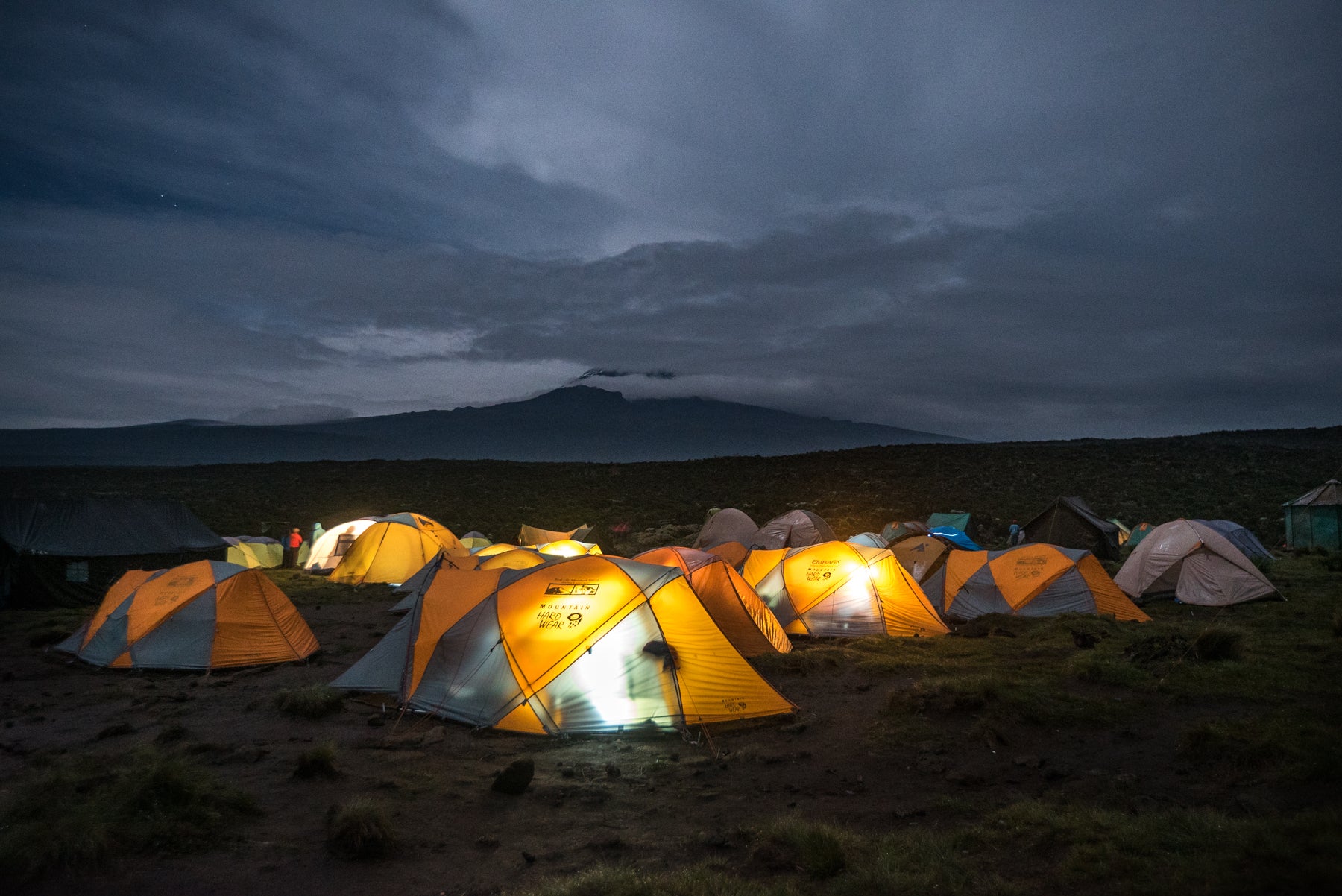
A relatively easy hiking day ascending out of the jungle and heather has found us at Shira 1 Camp, at the edge of an expansive 11,000 ft plateau. We’ve been hiking into the clouds and visibility for much of the day has been poor to none. Arriving in camp, we can sense that there is a view to be had but it isn’t until late in the evening when most of the climbers have gone into their tents that the mountain begins to reveal herself. As the fog pockets ebb and flow across the plateau, Kilimanjaro begins to emerge in full view…the first time we’ve seen the mountain. A surreal scene unfolds as climbers in dozens of tents across the camp shift and shuffle with their headlamps, illuminating the colorful tents. Off in the distance, a lightning storm behind Kilimanjaro flashes ever few minutes, backlighting the massive snow capped mountain. We’ve got several cameras set up shooting stills, video, and motion time-lapse sequences and the low light capacity of the Sony α7S II cameras is making us giddy with their ability to capture the light show. –John Waller
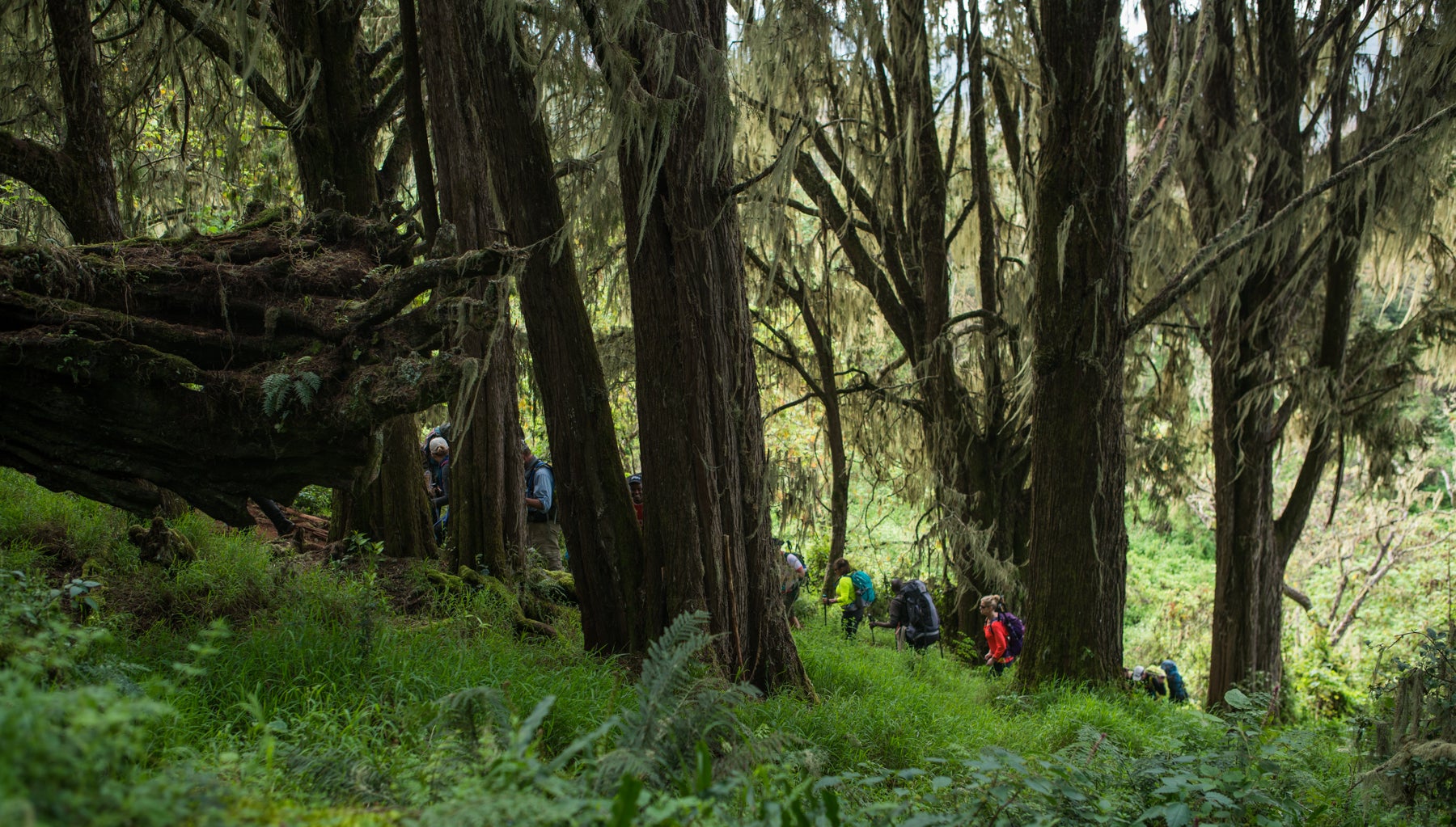
I love that we’re really hiking through a rain forest. I heard the Kilimanjaro trek passes through distinct climate zones, but I figured it was an exaggeration to build up the interest in the climb. Nope. It’s real. We woke up to the cries of monkeys in the morning, the trees are massive, green is the color of everything and humidity makes all effort a sweaty mess. I’m beginning to find a rhythm of jetting in front of the group to find a shot I want them to pass through, wait for them… wait for them… get the shot, then hustle back ahead to find the next moment. The group is just beginning to get to know us and they jokingly refer to us as “portagraphers” since we’re carrying larger camera bags and continuously passing them to get ahead for another shot. Trail etiquette is step to either side when you hear a breathless “left side!” coming up behind you. This trail is literally a highway of people and gear moving up. – Ben Canales
Day 3

The clouds unleash today in a sustained torrential downpour for hours. Big fat raindrops hammer down on us relentlessly as we trek across the Shira plateau. Everything is soaked. Our non-essential camera equipment has been shuttled ahead to camp in SealLine dry bags…the kind you would use on a whitewater rafting trip… And we do our best to keep our basic camera set-ups from getting waterlogged by keeping them in plastic bags. We have a phrase that we like to toss around…”put it in the garbage”…which is our propensity for filmmaking in really unpleasant and unforgiving conditions. That’s sometimes when and where the most compelling and dramatic footage is shot. So despite the responsible voice in our head’s that remind us that cameras and water don’t play well together, we can’t help but shoot in the deluge. By the time we arrive in camp, our Sony gear is hammered, but still functioning…testimony to the engineering and durability of these a7S II cameras. – John Waller
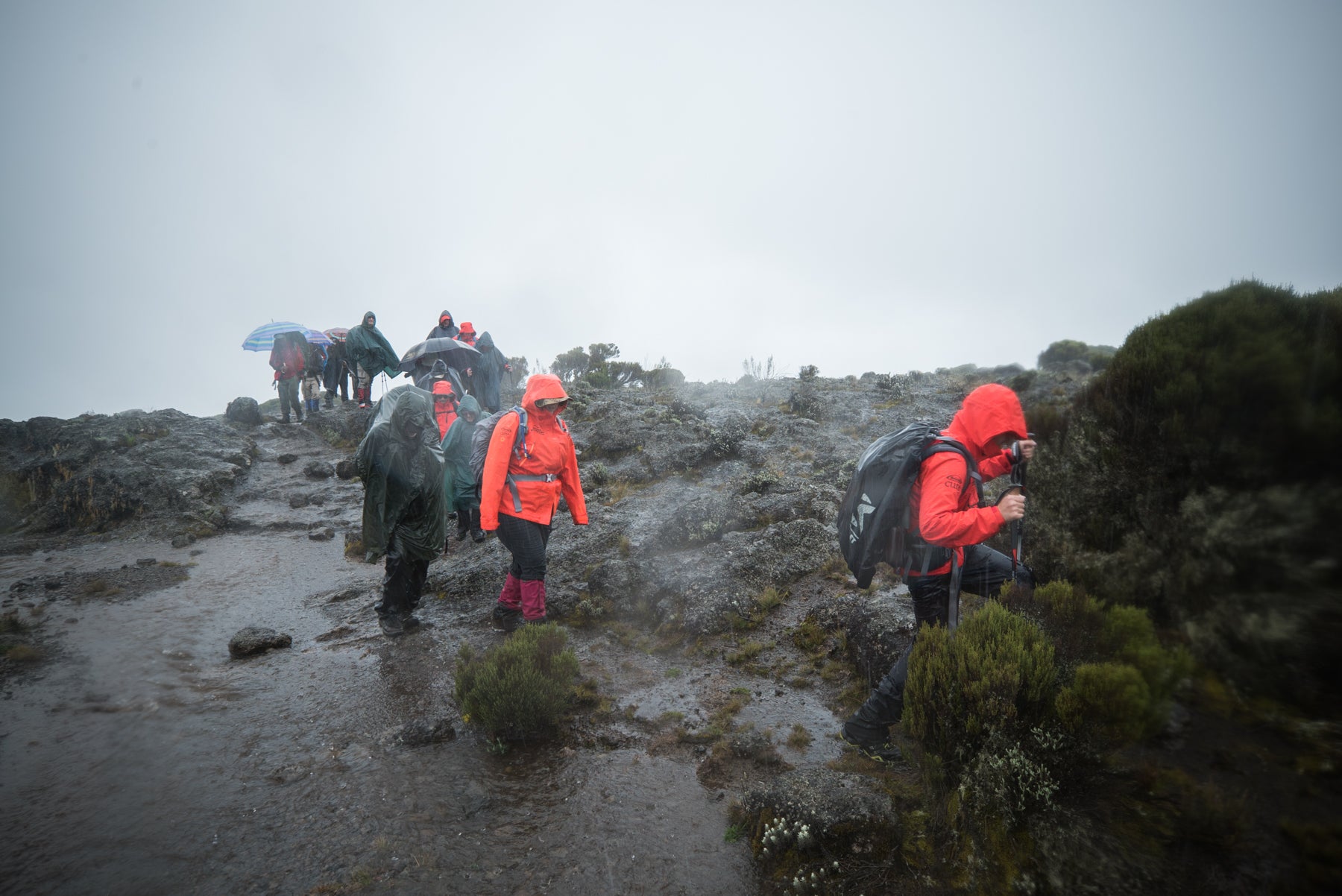
Ugh. It rained HARD the last hour to camp. I wasn’t fully ready for a downpour. Occasional rain I was setup to handle, but it went from drizzle to monsoon dump in 30 seconds and didn’t let up for over an hour. Ten minutes in, I found a bush to huddle under and repacked gear, set the camera in a Ziplock bag and fashioned a trash bag to cover my pack with the tripods on the outside. I expected the α7S II to brick and turn off at any point because of how much water it was taking on, but dripping wet it kept on shooting until we made it to camp and got the final shots of everyone in glorious suffering of the bad weather. While the event unfolded, I knew this would be the down-point to the summits up-point in the final film. When it sucks, that’s usually when the real good stuff happens. At camp, we disassemble everything and lay it out to dry in our tent. I cringe looking at camera sensors uncovered and lenses drying from the inside out. – Ben Canales
Day 4

The trek today was by far the longest distance and most elevation covered so far. In over 10 miles, the group ascends up to over 15,000 feet and then back down to Barranco camp at 13,000 ft. It’s a big day, and the weather has been dreary and cold. At those altitudes, you can really begin to feel the effects of less air—your pace slows considerably and every step is labored. Deep breaths just don’t quite satisfy like they do in the jungle. But our guides and porters seem almost unaffected by the weather, the distance, or the elevation. They’re nothing but smiles and fist bumps. We’ve nicknamed the porters assigned to us to carry the camera gear Kilimanjaro Studio and they wear the title proudly. Their preferred carrying technique is balancing loads on their head and they do it with grace and style…even awkward and bulky loads…even loads like our SealLine bags which have great suspension systems and shoulder straps…they still prefer the head carry. I have such deep respect for these porters and the daily hard work they do with relative ease. – John Waller
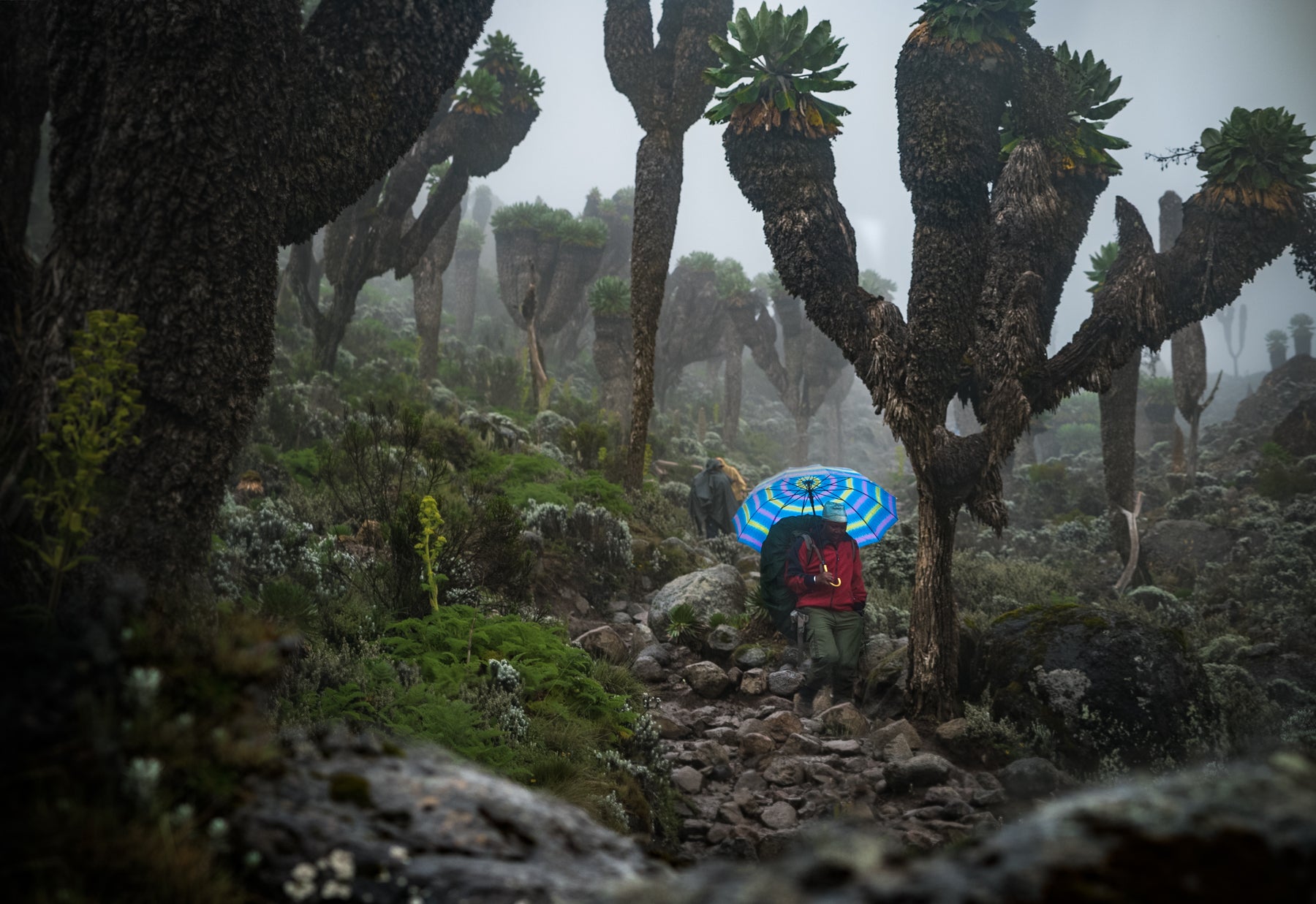
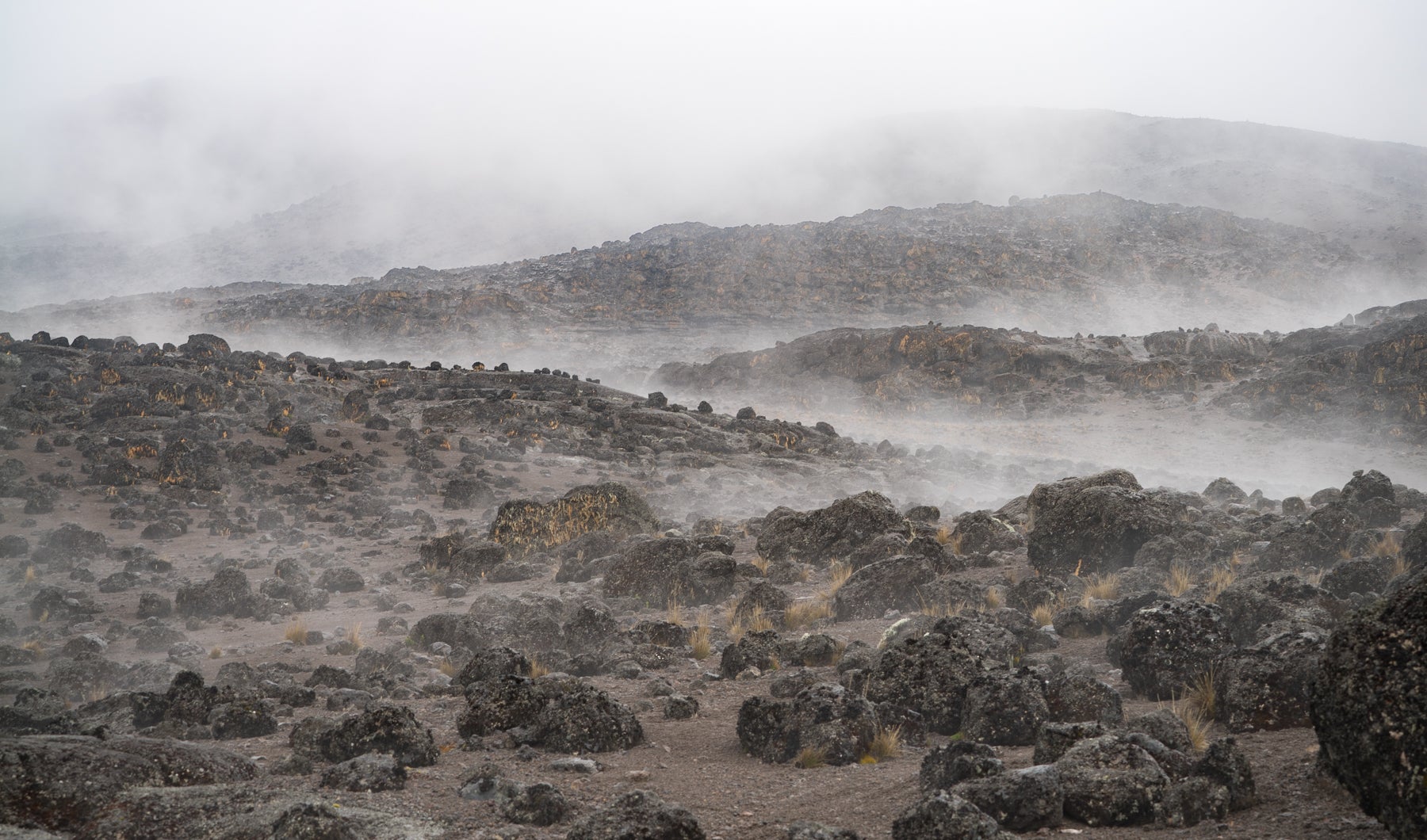
Dr. Seuss trees! Kilimanjaro continues to impress with such diverse terrain and now plant life like I’ve never seen. These trees, the dense fog and porters carrying cheap, colorful umbrellas had me wondering if the altitude was getting to me, or the bizarreness I was seeing was actually real. I’m frustrated we have to follow the group rather than adjust our schedule and stay to get shots of these trees in better light. But, camp is still a few miles down the trail and light is dropping. – Ben Canales

Darkness descends and sometime while in the mess tent, the clouds open up to show the mountain under a full moon and it is dramatic. We’re all a bit intimidated by tomorrow’s climb of the infamous Barranco Wall. –Ben Canales
Day 5

Its been cloudy for a number of days and our views of the mountain have been fleeting. But as we arrive in Karanga Camp at 14,000 ft. the dense fog begins to break and stunning views of the mountain are revealed. There is an exhilaration in camp as we can see now how close we are, but the views are humbling as we can see how much higher we still have to climb. White glacial fingers drop down off the summit toward rugged headwalls. What looked like a tame and gentle mound from a distance now shows up as an imposing mountain. Toward sunset the clouds disappear from the upper mountain completely and recede below us as a lapping ocean of fog. The summit turns yellow with alpine glow and the entire camp turns their attention to the beautiful show. Nervous smiles speak of both the wonder of the mountain’s beauty, but also to its intimidating presence. – John Waller
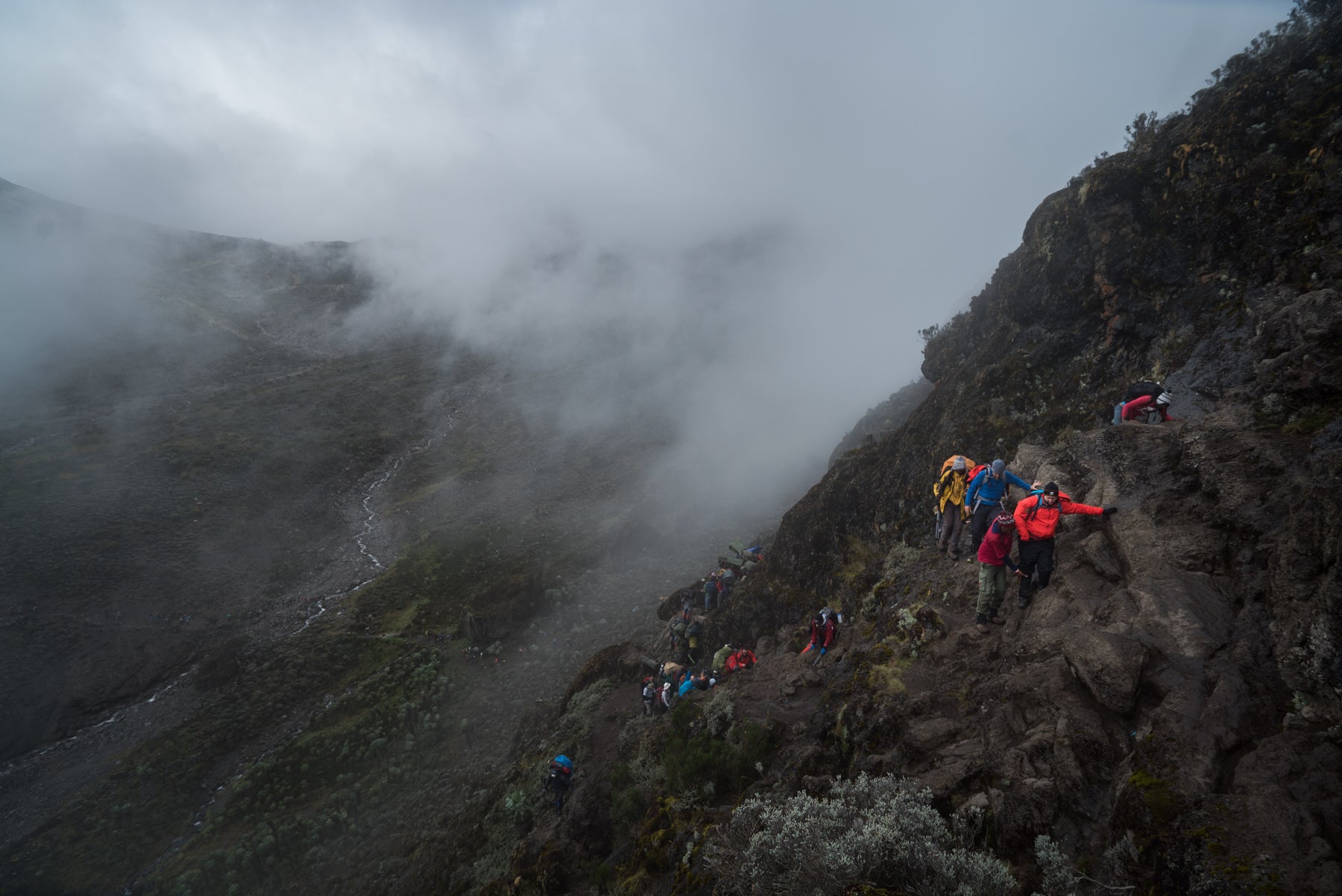

Our group we’re filming is a super diverse mix of outdoor-savvy and totally naive levels of experience. Today the inexperienced ones get to earn their ‘sketchy trails’ badge. The Barranco Wall is a steep and scrambling trail that is a chaotic challenge of climbing while being passed by porters carrying ridiculous loads. Here, the highway of people seems like a disaster waiting to happen. – Ben Canales
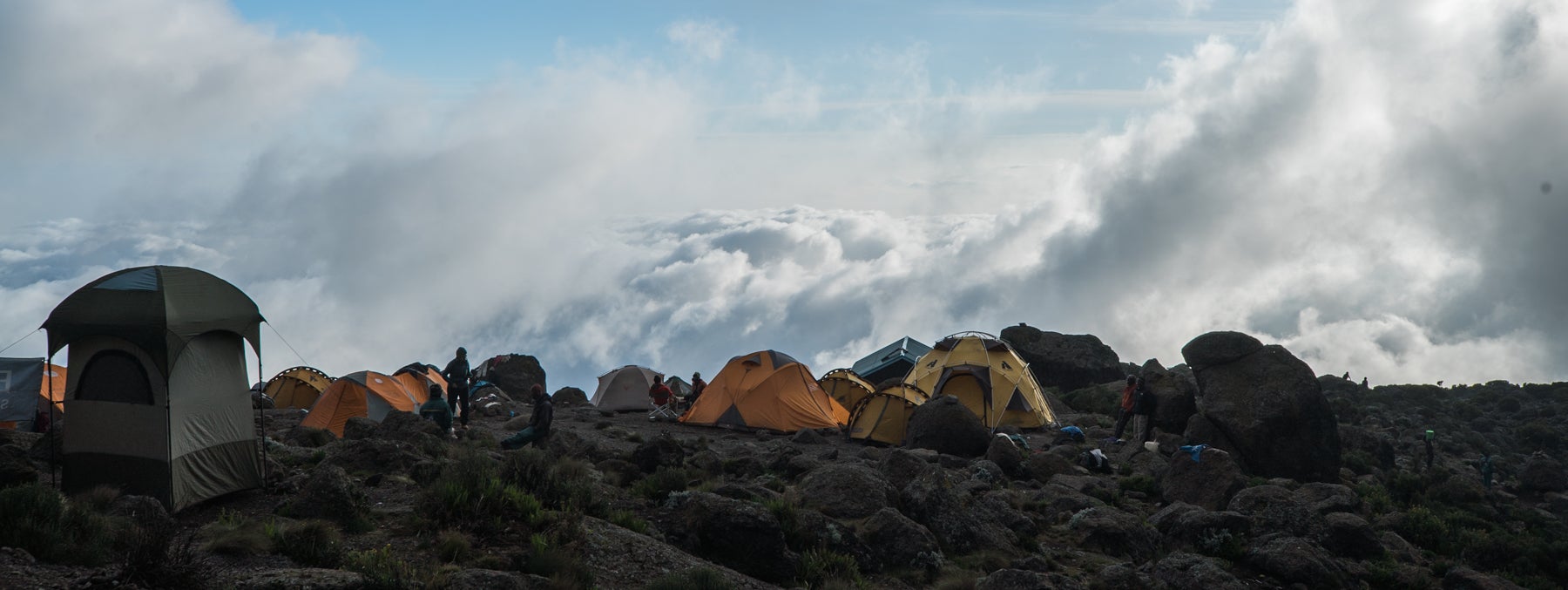
Finally, the clouds clear and we feel on top of the world. At 14,000’ camp we are looking down at the clouds and it gives a new energy to tired legs. Finally, the weather is clearing and what a view to reveal! John and I rush to the α7S II cameras shooting timelapse when the view breaks open. It’s Day 5, and by now the guiding group knows without asking to hold some food for us if there’s a sunset happening during the usual dinner time. – Ben Canales
Day 6
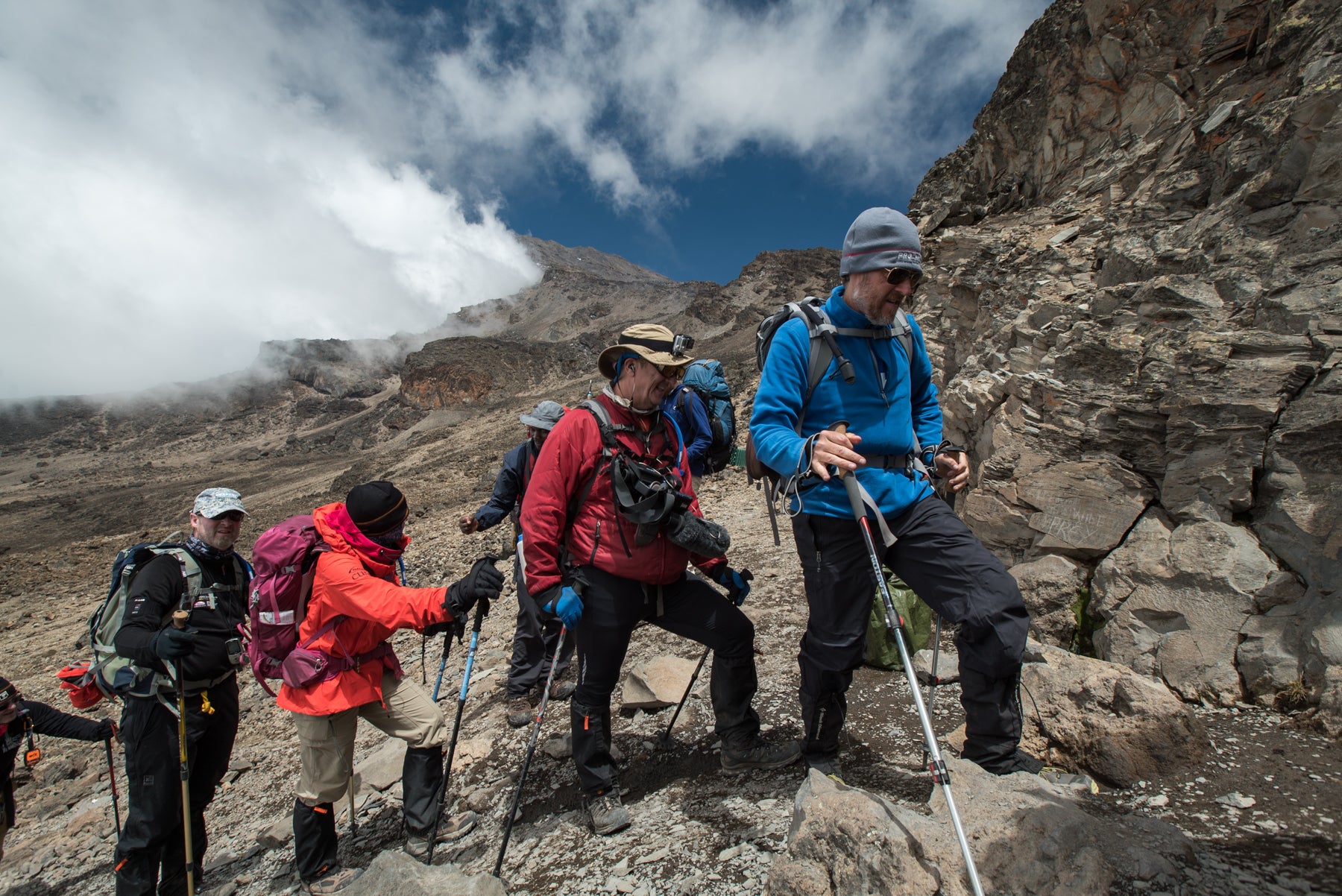
Bob Dickey (in blue) is one of the four cancer patients on the climb who is battling an incurable form of blood cancer called Multiple Myeloma. A healthy lifestyle, stem cell treatments, and a course of new drugs have prolonged his life and his quality of life, but the battle is ongoing. Bob says that “there is no reason that your life is over with a diagnosis of Multiple Myeloma” and he has shifted his perspective about the important things in life. Relationships, experiences, and maintaining a healthy lifestyle are his new priorities. And while climbing Kilimanjaro is an exceptional challenge for him, he feels hopeful and confident that he’ll be able to make it. But he also realizes that not everyone with cancer will have the capacity to make this kind of climb so he challenges all of us to ask ourselves, “what is your Kilimanjaro?”…what is that thing for you that seems on the edge of impossible… and put one foot in front of the other to realize that goal. – John Waller

We’re above the clouds and the mountain summit is always within sight. The team is settling into their own individual reaction to the demanding challenge. This evening we take a short nap (or try to) and get up at 9pm for dinner and an 11pm start for the summit. The clouds lap at the edge of camp, tents are squished in the few kind-of flat spots. I’m antsy to go. – Ben Canales
Summit

Kilimanjaro Summit, 19,341 ft, Jan 22
Somewhere in my environmental science program at Willamette University 20 years ago, I had been introduced to the quickly disappearing glaciers of Kilimanjaro...the kernel of intrigue had been planted and then put away on some deep back shelf as life piled on all its happenings. But that interest resurfaced this winter when the opportunity came up to climb Kilimanjaro with Moving Mountains for Multiple Myeloma. When the group had left the summit heading back down I stayed a little while longer to complete my own pilgrimage to the glaciers on Kilimanjaro. A short walk down from the summit you arrive at these surreal towering walls of ice that abruptly rise up 60 feet from the soft gravel surface. I put my hand on the blue ice and felt a several decade dream come to fruition. It brought me to tears. I was in a pretty raw place anyway...feeling pretty worked from the climb, altitude, and lack of sleep, emotional from the shared experience with the Moving Mountains group, and enthralled by the otherworldly landscape. But something else was going on...a sense of sadness with what felt like goodbye. By many accounts these 10,000 year old glaciers could disappear by 2030. So yeah, there's all kind of debate about the role that humans and climate change play in this and everyone has an opinion about why, and when, and who or what is to blame, or what any of us can actually do about it. In that moment standing next to that massive face of ice, none of that noise really mattered. What I felt was a deep connection to a place, a tiny sliver on our planet, that is in the process of departing...for good...at least in my lifetime. I get it...the only constant in life is change and our landscape has always been and will always continue to change...acceptance, if not celebration is a helpful perspective. I just try to remember to express respect and love for our home along the way. – John Waller

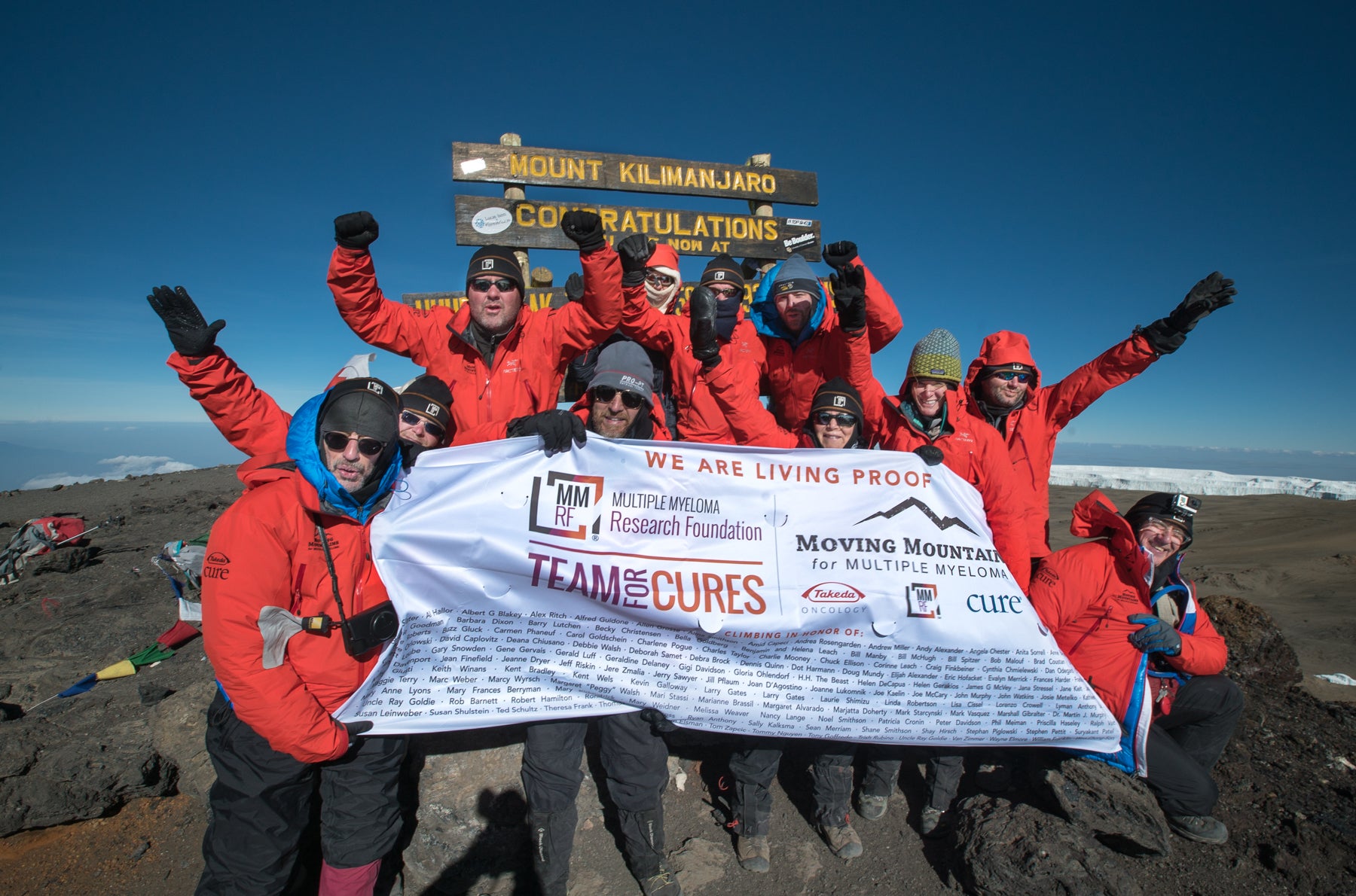
We start off in howling winds and a full moon. John and I give high fives when we find the moonlight is plenty to shoot handheld video with the α7S II’s high ISO. Literally, this wasn’t possible before these cameras. The winds are relentless, the climb is steep, and Kilimanjaro’s motto is “poli poli” or “slow slow.” The team advances one slow step at a time. Due to stomach bug, one drops back, due to blindness from altitude, another turns back. Around 17,500- most of the team is feeling altitude effects of some sort. A headache always roars quietly, I feel a debilitating nausea and just want to find a way to get the feeling to pass. But, these are expected symptoms and within safe limits, so with a break every two hours, we slowly continue. The sun rises, the team naturally breaks apart into a faster group and a slower group. We rally at Stella Point, the false summit at 18,500, the true summit is at 19,300 and 3/4 mile further. I finally relent to the offer of help from my porter guide and give him my backpack. Immediately I come back to life not having to carry the weight, he nonchalantly throws it over his shoulder and skips ahead unfazed. As a group, we make it to the summit. Hug, high fives, tears flow freely. I have to have a mini moment aside as memories of a best friend of mine passed from cancer overwhelm me at there at the top. Together, we all celebrate having reached the top. – Ben Canales
Day 7 & 8


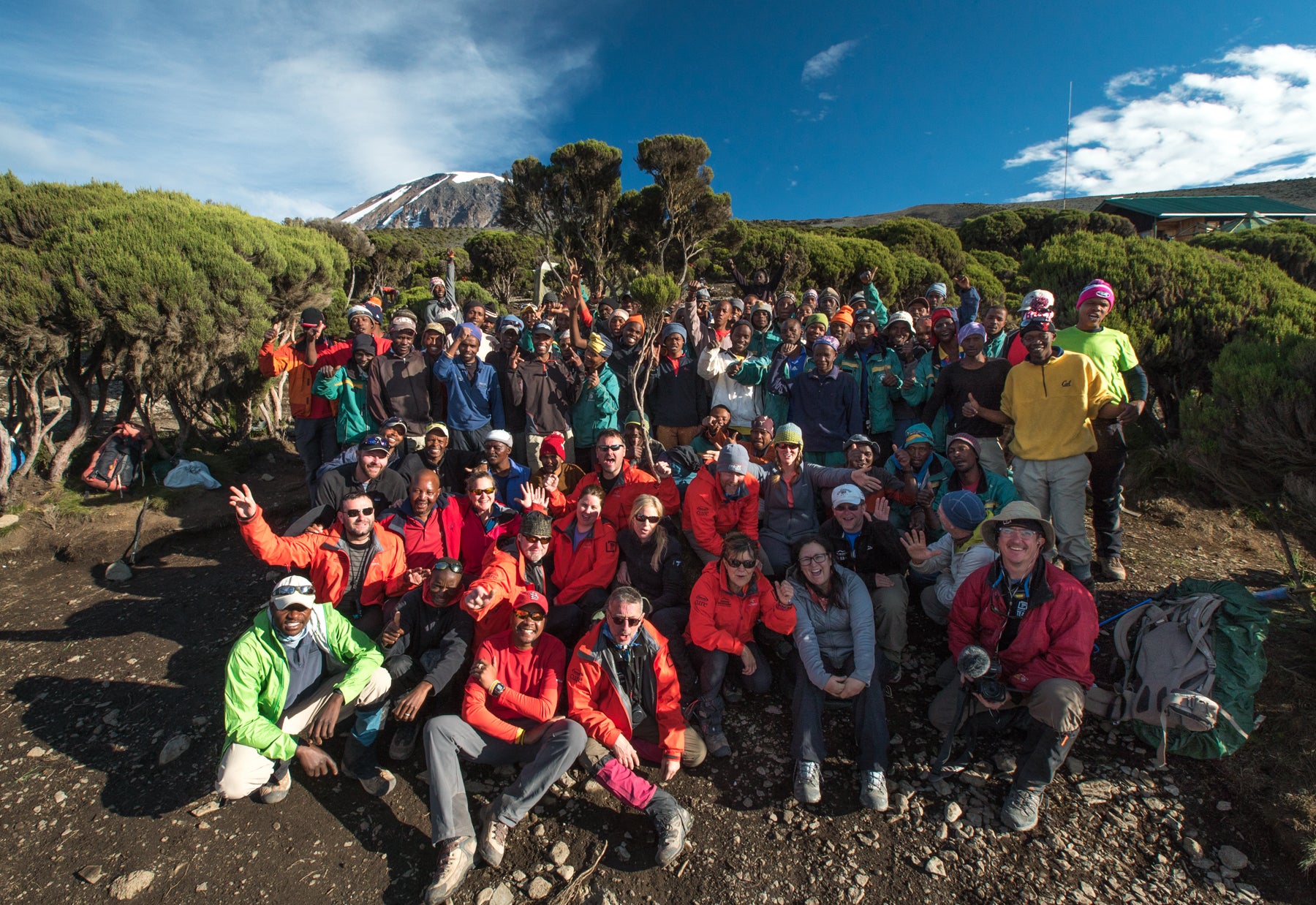
Our group of 17 and porters of 83 feels like a single crew with a mission accomplished. The hike down only gets better as we descend from 19,300 to 5,000 for our last camp with air thick enough to swim through. Sunrise is stunning. And, as we load gear for the last day, we’re down to our final few SD cards and batteries. On the exit through the Rain Forest, I get all fired up finding ‘crown shyness’ behavior in one specific part of the trail. The trees split apart into clumps and, for reasons not known, build a gap and don’t touch each other. I was mesmerized in that mile of trail watching them sway in and out of each other like a puzzle going together and coming undone. Finally, at the end of the trail, cold beers are the sweetest of luxuries. – Ben Canales
Watch the full documentary, Moving Mountains For Multiple Myeloma here:
You can learn more about the Moving Mountains For Myeloma climb here.
All photos by John Waller & Ben Canales, Uncage The Soul Productions
You can see more by Uncage The Soul Productions here.

